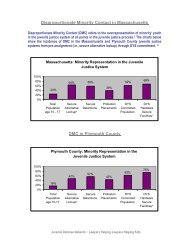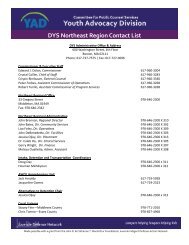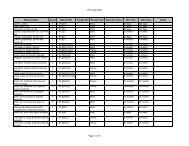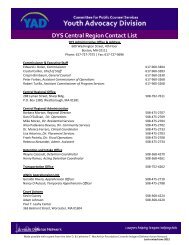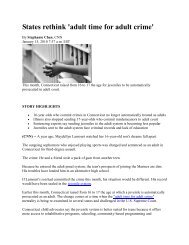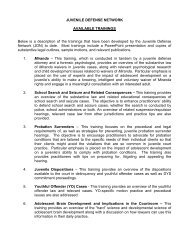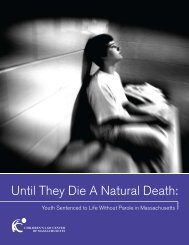Adolescent Brain Development - the Youth Advocacy Division
Adolescent Brain Development - the Youth Advocacy Division
Adolescent Brain Development - the Youth Advocacy Division
You also want an ePaper? Increase the reach of your titles
YUMPU automatically turns print PDFs into web optimized ePapers that Google loves.
• “Although states may hold youths accountable for <strong>the</strong> harms <strong>the</strong>y cause, Roper explicitly limited<br />
<strong>the</strong> severity of <strong>the</strong> sentence a state could impose on <strong>the</strong>m because of <strong>the</strong>ir diminished<br />
responsibility. Even after youths develop <strong>the</strong> nominal ability to distinguish right from wrong,<br />
<strong>the</strong>ir bad decisions lack <strong>the</strong> same degree of moral blameworthiness as those of adults and warrant<br />
less severe punishment.” (3)<br />
• “The court [in Roper] recognized that youths are more impulsive, seek exciting and dangerous<br />
experiences, and prefer immediate rewards to delayed gratification. They misperceive and<br />
miscalculate risks and discount <strong>the</strong> likelihood of bad consequences. They succumb to negative<br />
peer and adverse environmental influences. All of <strong>the</strong>se normal characteristics increase <strong>the</strong>ir<br />
likelihood of causing devastating injuries to <strong>the</strong>mselves and to o<strong>the</strong>rs. Although <strong>the</strong>y are just as<br />
capable as adults of causing great harm, <strong>the</strong>ir immature judgment and lack of self-control reduces<br />
<strong>the</strong>ir culpability and warrants less-severe punishment.” (6)<br />
• “Roper’s diminished responsibility rationale provides a broader foundation to formally recognize<br />
youthfulness as a categorical mitigating factor in sentencing. Because adolescents lack <strong>the</strong><br />
judgment, appreciation of consequences, and self-control of adults, <strong>the</strong>y deserve shorter sentences<br />
when <strong>the</strong>y cause <strong>the</strong> same harms. <strong>Adolescent</strong>s’ personalities are in transition, and it is unjust and<br />
irrational to continue harshly punishing a fifty- or sixty-year-old person for <strong>the</strong> crime that an<br />
irresponsible child committed several decades earlier.” (10)<br />
Hillary Massey, 8 th Amendment and Juvenile Life Without Parole after Roper, 47 B. C. L. REV. 1083<br />
(2006).<br />
• Argues for elimination or limitation of JLWOP based on proportionality review and diminished<br />
culpability of juveniles.<br />
• “The psychosocial research shows strong differences between adolescents and adults that<br />
implicate assessments of culpability. Researchers have identified four psychosocial factors that<br />
affect <strong>the</strong> way adolescents make decisions, including whe<strong>the</strong>r to commit a crime or an antisocial<br />
act: peer influence, attitude toward risk, future orientation, and capacity for self-management. In<br />
one study, adolescents on average scored significantly lower than adults on <strong>the</strong>se factors and<br />
displayed less sophistication in decision making. Although individual levels of <strong>the</strong>se factors are<br />
more predictive of antisocial decision making than chronological age alone, researchers found<br />
that <strong>the</strong> period between ages sixteen and nineteen is an important transition point in psychosocial<br />
development.” (1090)<br />
Staci Gruber & Deborah Yurgelun-Todd, Neurobiology and <strong>the</strong> Law: A Role in Juvenile Justice? 3 OHIO<br />
ST. J. OF CRIM. L. 321 (2006).<br />
• Summarizes adolescent neurobiology research and argues that brain differences due to immature<br />
development, like brain differences due to disease, be taken into account in justice system.<br />
• “[N]eurobiological studies … indicate that <strong>the</strong> cerebral cortex undergoes a dynamic course of<br />
metabolic maturation that persists at least until <strong>the</strong> age of eighteen. … Younger, less cortically<br />
mature adolescents may be more at risk for engaging in impulsive behavior than <strong>the</strong>ir older peers<br />
for two reasons. First, <strong>the</strong>ir developing brains are more susceptible to <strong>the</strong> neurological effects of<br />
external influences such as peer pressure. Second, <strong>the</strong>y may make poor decisions because <strong>the</strong>y are<br />
cognitively less able to select behavioral strategies associated with self-regulation, judgment, and<br />
planning that would reduce <strong>the</strong> effects of environmental risk factors for engaging in such<br />
behaviors.” (330)<br />
• Steps for defense attorneys to take to understand a client’s state of mind and baseline levels of<br />
functioning are listed on p. 332.





